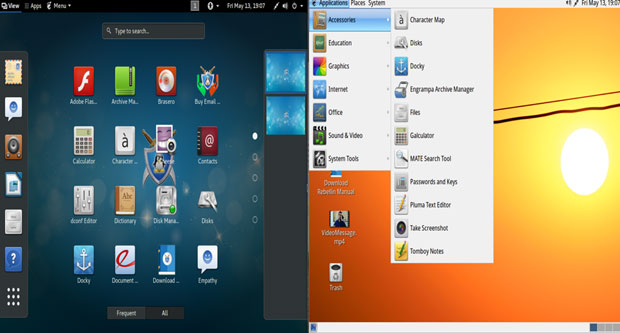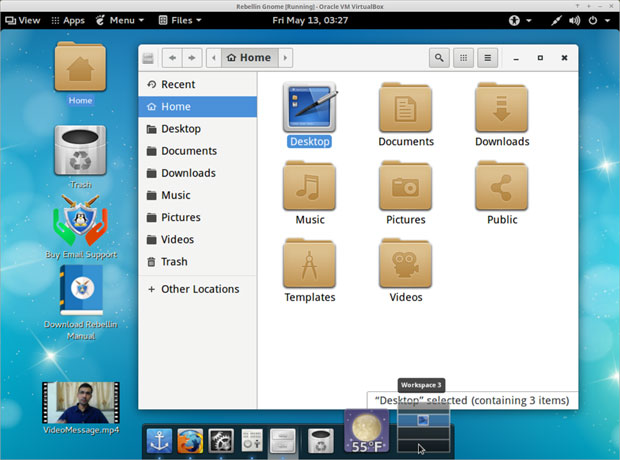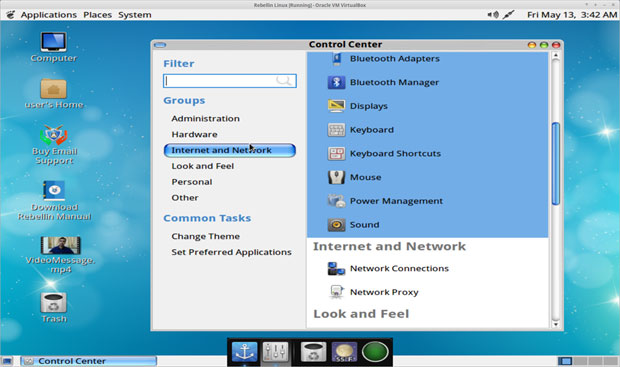
![]()
Rebellin Linux is a smart-looking, fast distro that is both lightweight and secure. It is well worth checking out.
The Rebellin line avoids the pitfalls that befall many Debian GNU/Linux derivatives. It does not maintain a warehouse full of desktop versions. It is neither a minimalistic Linux line nor a distro stuffed with bloat from packages typical users will never need.
Instead, it comes well loaded with essential applications, drivers and codecs to provide a very uncomplicated out-of-the-box user experience. The Rebellin Linux project is very beginner-friendly.
Rebellin prominently displays on the desktop a link to a free download of a user guide. The guide makes new users to the Rebellin distro in particular and the Linux OS in general feel right at home. Add to this welcome the direct link to email tech support by the developer team, and you have a near-perfect new-user solution without the chore of scrolling through help forums.
The new release marks a change in direction for the development path. Until now, the project offered two separate versions: The Synergy version was based on Debian’s latest stable version, and the Adrenalin version was based on Debian’s unstable branch.
The release this month of Rebellin version 3.0 eliminates Synergy and drops the Adrenalin name to better show a unified distro. The current version is a stable system built on Debian Sid that is reliable for day-to-day use.
That was a smart move by the lead developer. Rather than continue straining resources in light of lagging user support for both development paths, the new release cycle lets the developer focus on improving what users want.
The release comes fully loaded with essential applications, drivers and codecs to provide an out-of-the-box experience. Rebellin is superfast, lightweight and secure.
What’s New
Rebellin 3.0 runs the latest GNOME shell (version 3.20). The Mate edition runs Mate version 1.12, which is an update from an earlier version when Rebellin added the Mate desktop environment.
Mate is a fork of GNOME 2, a popular desktop choice before the GNOME community drastically changed the user interface with the release of GNOME version 3. However, despite the newer Mate version in Rebellin 3.0, the desktop is still slightly behind the current Mate release cycle. Mate version 1.145 was released last month, as well as new fonts and hardware support courtesy of an updated Linux kernel, version 4.5.
Rebellin runs the latest Linux Kernel version 4.5. Other changes include replacing GNOME Terminal with Terminator, a move necessary to improve shell stability. VLC replaced Totem as the default media player. Redundant software removed for building a lighter product.
LightDM replaced GDM3 as the display manager. That was prompted as a fix for the blank screen GDM3 caused on startup.
Desktop Delight
I look at several new Linux distro releases each week. Few of them impress me on first run for having anything different or exciting. Rebellin Linux is one of those few.
One of the great strengths of the Linux OS is the numerous desktop choices. However, that can be Linux’s biggest deal breaker for new users — so many choices adds to the confusion of learning to use a new computer system.
Rebellin Linux narrows that choice to two. You can have the old GNOME desktop made new by Mate, or you can have the latest GNOME desktop simplified by well-designed tweaking.
Rebellin caters to ease of use. That offers newcomers a reason to start their Linux experience with Rebellin. It also is inviting for more seasoned Linux users who want to return to an uncomplicated UI without sacrificing power or popular packages.

Heavenly Highlights
The GNOME desktop is modern and easy to use. The panel bar sit across the top of the screen with just a few notification icons on the right and menu launchers on the left.
One launcher opens a dual column list of apps arranged by category. A second panel icon launches apps in a full-screen display with search window on top and the favorites list in a vertical row at the left of the screen. A third panel icon shows a scaled view of the desktop and the favorites list. Off the right edge of the screen slides the workspaces thumbnail view. Click the View icon again to show the full desktop.
On the panel bar is a workplace switcher that makes moving from one workspace to another easy without going through the view launcher. GNOME functionality does not get easier than this.
The Mate desktop offers old-school GNOME functionality with a modern toolset. It places a fully functional panel at the top of the screen and an optional Docky launcher at the bottom of the screen. The workplace switcher is preconfigured. The panel has the traditional notification area at the right end and the launchers for Menu, Places and System apps on the left end. You can place any menu item on the desktop, panel or elsewhere by right-clicking on its title in the menu list.
Both desktop options give you ample configuration options and numerous settings panel. Both also offer control panel displays to place all the user preference settings in one handy location.
Bottom Line
Both versions generally performed well. The Rebellin distro is impressive considering its small development team.
Rebellin is not without a few glitches, however. One major problem I had with several of my computers testing the distro was with the audio playback in both the GNOME and the Mate editions. It did not play back. I double checked all the settings, even making sure that the mute option was not checked.
Another issue affected just the Mate edition. The touchpad settings are not available, and the Touchpad tab itself is missing. The Synaptics Touchpad Driver is not being loaded in Rebellin Mate, according to Rebellin’s developer. He posted a workaround that may temporarily resolve the problem. It is a multistep process that is not very straightforward.
Want to Suggest a Review?
Is there a Linux software application or distro you’d like to suggest for review? Something you love or would like to get to know?
Pleaseemail your ideas to me, and I’ll consider them for a future Linux Picks and Pans column.
And use the Talkback feature below to add your comments!
























































My biggest complaint of Linux is that many distro’s offer far too many options that are totally confusing to the new user. I think much of that comes from a overly technology based thought process trying to be all things to all users. I think it’s why devices like Chromebook’s have become popular because the OS is not up front and requiring any attention. It handles hardware and then you have a browser. Personally, Linux could take some things from Chrome OS and do something like this Rebellin and focus more on basics. I thought Ubuntu was good at first, and then Mint came along. But they all seem to bloat up too much and begin to expand far too much. Because I generally run Linux on weaker hardware, I prefer a less is more Linux.